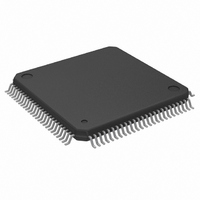HD6413007F20 Renesas Electronics America, HD6413007F20 Datasheet - Page 537

HD6413007F20
Manufacturer Part Number
HD6413007F20
Description
IC H8 MCU ROMLESS 5V 100QFP
Manufacturer
Renesas Electronics America
Series
H8® H8/300Hr
Datasheet
1.D13007F20V.pdf
(798 pages)
Specifications of HD6413007F20
Core Processor
H8/300H
Core Size
16-Bit
Speed
20MHz
Connectivity
SCI, SmartCard
Peripherals
DMA, PWM, WDT
Number Of I /o
35
Program Memory Type
ROMless
Ram Size
4K x 8
Voltage - Supply (vcc/vdd)
2.7 V ~ 5.5 V
Data Converters
A/D 8x10b; D/A 2x8b
Oscillator Type
Internal
Operating Temperature
-20°C ~ 75°C
Package / Case
100-QFP
Lead Free Status / RoHS Status
Contains lead / RoHS non-compliant
Eeprom Size
-
Program Memory Size
-
Available stocks
Company
Part Number
Manufacturer
Quantity
Price
- Current page: 537 of 798
- Download datasheet (5Mb)
Table 14.8 Smart Card Interface Mode Operating States and Interrupt Sources
Operating State
Transmit Mode
Receive Mode
Data Transfer by DMAC: The DMAC can be used to transmit and receive data in smart card
mode, as in normal SCI operations. In transmit mode, when the TEND flag is set to 1 in SSR, the
TDRE flag is set simultaneously, generating a TXI interrupt. If the TXI request is designated
beforehand as a DMAC activation source, the DMAC will be activated by the TXI request and
will transfer the next transmit data. This data transfer by the DMAC automatically clears the
TDRE and TEND flags to 0. In the event of an error, the SCI automatically retransmits the same
data, keeping the TEND flag cleared to 0 so that the DMAC is not activated. The SCI and DMAC
will therefore automatically transmit the designated number of bytes, including retransmission
when an error occurs. When an error occurs, the ERS flag is not cleared automatically, so the RIE
bit should be set to 1 to enable the error to generate an ERI request, and the ERI interrupt handler
should clear ERS.
When using the DMAC to transmit or receive, first set up and enable the DMAC, then make SCI
settings. DMAC settings are described in section 7, DMA controller.
In receive operations, an RXI interrupt is requested when the RDRF flag is set to 1 in SSR. If the
RXI request is designated beforehand as a DMAC activation source, the DMAC will be activated
by the RXI request and will transfer the received data. This data transfer by the DMAC
automatically clears the RDRF flag to 0. When an error occurs, the RDRF flag is not set and an
error flag is set instead. The DMAC is not activated. The ERI interrupt request is directed to the
CPU. The ERI interrupt handler should clear the error flags.
Examples of Operation in GSM Mode: When switching between smart card interface mode and
software standby mode, use the following procedures to maintain the clock duty cycle.
• Switching from smart card interface mode to software standby mode
1. Set the P9
output state in software standby mode.
4
data register (DR) and data direction register (DDR) to the values for the fixed
Normal
operation
Error
operation
Error
Normal
Flag
TEND
ERS
RDRF
PER, ORER
Enable Bit
TIE
RIE
RIE
RIE
Rev.5.00 Sep. 12, 2007 Page 507 of 764
Interrupt
Source
TXI
ERI
RXI
ERI
14. Smart Card Interface
REJ09B0396-0500
DMAC
Activation
Available
Not available
Available
Not available
Related parts for HD6413007F20
Image
Part Number
Description
Manufacturer
Datasheet
Request
R

Part Number:
Description:
KIT STARTER FOR M16C/29
Manufacturer:
Renesas Electronics America
Datasheet:

Part Number:
Description:
KIT STARTER FOR R8C/2D
Manufacturer:
Renesas Electronics America
Datasheet:

Part Number:
Description:
R0K33062P STARTER KIT
Manufacturer:
Renesas Electronics America
Datasheet:

Part Number:
Description:
KIT STARTER FOR R8C/23 E8A
Manufacturer:
Renesas Electronics America
Datasheet:

Part Number:
Description:
KIT STARTER FOR R8C/25
Manufacturer:
Renesas Electronics America
Datasheet:

Part Number:
Description:
KIT STARTER H8S2456 SHARPE DSPLY
Manufacturer:
Renesas Electronics America
Datasheet:

Part Number:
Description:
KIT STARTER FOR R8C38C
Manufacturer:
Renesas Electronics America
Datasheet:

Part Number:
Description:
KIT STARTER FOR R8C35C
Manufacturer:
Renesas Electronics America
Datasheet:

Part Number:
Description:
KIT STARTER FOR R8CL3AC+LCD APPS
Manufacturer:
Renesas Electronics America
Datasheet:

Part Number:
Description:
KIT STARTER FOR RX610
Manufacturer:
Renesas Electronics America
Datasheet:

Part Number:
Description:
KIT STARTER FOR R32C/118
Manufacturer:
Renesas Electronics America
Datasheet:

Part Number:
Description:
KIT DEV RSK-R8C/26-29
Manufacturer:
Renesas Electronics America
Datasheet:

Part Number:
Description:
KIT STARTER FOR SH7124
Manufacturer:
Renesas Electronics America
Datasheet:

Part Number:
Description:
KIT STARTER FOR H8SX/1622
Manufacturer:
Renesas Electronics America
Datasheet:

Part Number:
Description:
KIT DEV FOR SH7203
Manufacturer:
Renesas Electronics America
Datasheet:











